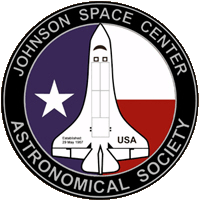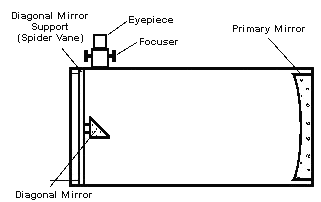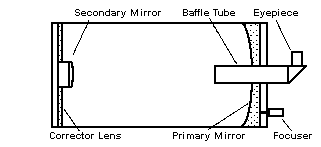
Welcome to the:
Johnson Space Center Astronomical Society (JSCAS) web site.
JSCAS is an association of amateur astronomers dedicated to the study and enjoyment of astronomy since 29 May 1967.
Buying a Telescope...
"What telescope should I get?" -- This is a common question that is heard at "star party's" all over the country and variations around Birthdays and Holidays. This is a very difficult question to answer as choosing a telescope is much like choosing an automobile, camera, or even a house! It is a personal choice. It all depends on what you want. There is no best choice for everyone and the one that would be best for you will depend on your lifestyle, your observing goals, and of course your budget.
If you have attended a star party and have been intrigued with what you've seen, GREAT! In addition to maintaining your enthusiasm, the best thing you can do is keep your money in your wallet and invest a little bit of time in examning what types of telescopes are avialable. The best thing you can do is look over this page and go back to a star party armed with questions --- and if there is one thing we amateur astronomers love to do is to look into the sky, talk and answer questions! Once you are familiar with the various features of the three types of telescopes (discussed below) you will be better suited to make an "informed decision" and you'll likely be happier with your choice!
POWER is not the ultimate feature. Among the features that go into the power of a telescope, the most important item is the telescope's light gathering ability. This is what is called "aperture" or simply stated, how large the telescope's mirror or lens is. Another less important feature that determines magnification is what is called the "focal length" of the telescope, or simply how long the telescope is. Although the power is variable, each telescope used under average skies has a limit to its highest useful magnification. The limits of resolution center, almost exclusively, on the telescope's aperature. As a general rule, multiply 50 times every inch of aperture (diameter) will give you an indication of the maximum magnification the telescope can provide. Using this rule, a four-inch telescope can maximally provide 200X magnification.
However, a trip down the iles of large department store chains, various mail-order catalogs, and even "membership warehouses" you will sometimes find telescopes enticing you with 450X or 575X (or more!) power. Do not be deceived by these ludicrous claims! The manufacturer is determining these numbers by another, less important, factor of magnification - namely the focal length of the telescope. In this manner, the magnification can be determined by dividing the focal length of the telescope by the focal length of the objective being used. So, for a four-foot telescope (1220mm) would have a magnifcation of 244X if a 5mm objective (eyepiece) were used. Yet, from above, this same telescope can only maximally provide 200X magnficiation based on its aperature. The difference in magnificaiton from 200-244 is what is called "empty magnification" where there is no corresponding increase in resolution. What is "fuzzy" with additional empty magnification will only become bigger and "fuzzier"!
Based on the telescope's aperature (light gathering ability), these "Department Store Telescopes" (a.k.a., "Holiday Telescopes"), often have their sharpest images at powers of 25-50X and even still, they may often have inferior optics. Despite the temptation, the price, and well meaning family members or office co-workers, these telescopes are best left on the shelf.
Types of Telescopes. When considering telescopes, we will consider the features of the three types of telescopes described below.
Refractors - When most people think of telescopes, they tend to think of a long tube where they look into one end and point the other at the object they want to see. This type of telescope is called a "Refractor telescope". A small, good quality refractor of 60-80mm aperture makes a very good starter telescope for viewing the moon and major planets and even some terrestrial viewing. They tend to be inexpensive, portable, and maintenance-free -- all desireable factors in a telescope. Yet, if viewing deep-sky objects such as nebulas and galaxies are your goals, these "beginner" telescopes are not well suited for these tasks. A Reflector or Schmidt-Cassegrain telescope would be a better choice especially if what you can comfortably spend is a factor in choosing a telescope. Going to a larger refractor is a possibility to observe deep sky objects; however, the larger aperture will command a much higher price.

Reflectors - The Reflector telescope is a very popular, powerful, and economical astronomical telescope. It was invented by Sir Issac Newton and is often called a Newtonian Reflector. Its simple design provides tremendous light-gathering ability and these telescopes are well suited for both planetary and deep-sky observing. As shown in the figure, incoming light is reflected off a concave "primary" mirror at the base of the tube. This light travels from the primary mirror up to a smaller, flat "secondary" mirror near the top end which is then reflected out of the tube into the eyepiece (objective). Newtonian telescopes with primary mirrors of 6-8 inches can deliver spectacular imgages of deep-sky objects. The trade-off with reflectors is that they are not well suited for terrestrial viewing and with increasing aperture, the weight and size proportionally increases as well. A 6-8" Newtonian telescope can be handled by one person, but the portability of the telescope goes down as the size goes up.

Schmidt-Cassegrains - The Schmidt-Cassegrain telescope (SCT) is a popular design due to its compact design and versatility. Unlike the Newtonian reflector, the optical tube is short as the light traverses the inside of the tube three times. As shown in the figure, light comes in through a corrector lens in the front of the telescope. It is then reflected off the primary mirror at the back of the tube that is relfected off a secondary mirror on the inside of the corrector lens into the objective. These telescopes can pack an impressive aperture into a small space and can provide excellent views of the moon, planets, and deep-sky objects. The Schmidt-Cassegrain is also well suited for both film and CCD astrophotography. However, the SCT is also a considerable investment as even a basic 8 inch model can run over $1000.

The basic operation of a Schmidt-Cassegrain telescope. These are very compact telescopes due to the fact that the light passes three times through the length of the tube.
"Other things to consider..." - Another factor to consider is the mount upon which the telescope rests. Three types of mounts are used to support telescopes: altazimuth, Dobsonian, and equatorial mounts. The altazimuth mount is a heavier version of a traditional tripod that is used for photographic purposes. It is the simplest mount and is recommended for terrestrial observing and casual stargazing.
The Dobsonian mount is often made of wood or particle board and has a "boxy" shape. Using nyon or teflon riders, it is designed for easy manuvering of large telescope tubes and are very economical for mounting a telescope and are easily transported.
Equatorial mounts are more complex, heavier, and more expensive than the previous two. However, equatorial mounts allow the operator to follow the motion of celestial objects and can be controlled by hand or even automatically by computer. Again, you need to consider your lifestyle, budget, and what your viewing habits may be. Can you view the sights from your backyard or will you have to take your telescope to another locale? In this case, the portability of a telescope must be considered.
"What to do now?" If you are still interested in getting into amateur astronomy, the best thing you can do after reading this page is to go back to another star party. Do TWO things - 1) Look THROUGH the telescope at the celestial object, and 2) Look AT the telescope as well and and start asking questions. For more information consider purchasing the current issues of "Astronomy" and "Sky and Telescope" magazine at newstands. Also consider the web for information just follow the link page (JSCAS links page). When you decide to purchase a telescope, what you will want is to buy as much "aperture" as you can comfortably afford taking into account what you want to see! Again, ask questions if you're not sure and don't be "talk'ed" into anything by a salesman.
Also, if after learning more about telescopes, you come to the decision that you're still very interested in the heavens but not quite ready to buy a telescope, that's OK! You may already have a powerful tool to look at the stars and it may not cost you anything and may even be hiding in one of your closets - binoculars! A good pair of binoculars (7X50) is a great way to get started in astronomy and to learn your way around the sky. Many astronomers consider binoculars just as important to have in the accessory case as eyepieces for the telescope. If the stars are analogous to a forrest, the binoculars can show us the trees and their grouping, while the telescope can show us an individual tree, branch, or leaf.
"Want more information?" Here are some links that should provide you with additional information. The Orion Telescope company has a website and catalog that is full of useful and educational material, especially for beginners and advanced users that need telescopes or accessories. Another great place for shopping for telescopes and astronomy accessories is Astronomics.
In addition, there are two great publications that are out there on your newstands, "Sky and Telescope" and "Astronomy" magazines...
Copyright DLH and JSCAS.
Basic astronomy referenences...
1. "Nightwatch. A Practical Guide to Viewing the Universe" by Terence Dickinson, 3rd Ed.
2. "Advanced Skywatching" by The Nature Company.
3. "Touring the Universe through Binoculars" by Philip Harrington.